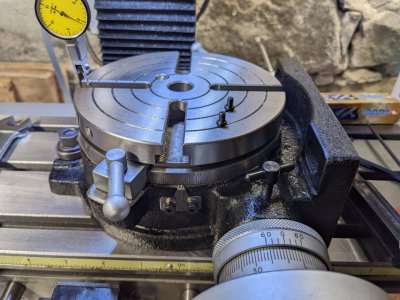- Joined
- Dec 18, 2019
- Messages
- 7,430
Not sure if the old iron was made "well" or not. Not relevant for my needs. RJ's table seems to be fine. Mine isn't.well, then we need to see what was going on in the 30s to the 70s here in the USA.. were they all as you think, or did they vary? I'm not sure.
Maybe we can ask some guys out there with some old equip what it looks like.

For me, the scale reads 3 degrees and 11 minutes, if I am getting this right. The horizontal slots are aligned with the x axis of the mill table. So shifting the pointer isn't really going to help. Crudely, it is fine. I can make a pointer to zero. But to get things precise, I have to set to x + 11 minutes to get everything to come out right. It may not matter to you, but I don't like that error. A 3 degree error is ok, but not convenient. 3 degrees + 11 minutes, no, that's no good, as it will lead to many screw ups in setting. A multiple of 4 degree error would be fine, as the dial would read correctly.
I am going to watch some rotary table teardown videos to see if I can understand this RT some more. Maybe it is adjustable, maybe not. Hope to learn some more about the table. The exploded part diagram I have is a print of a xerox of a xerox, if you catch my meaning. The detail is blurred, so I don't quite understand it. Once I understand it, I can tear it down, if I need to.

